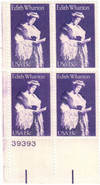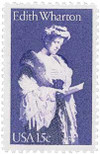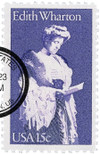
1980 15c Literary Arts: Edith Wharton
# 1832 - 1980 15c Literary Arts: Edith Wharton
$0.35 - $36.50
U.S. #1832
15¢ Edith Wharton
Literary Arts
15¢ Edith Wharton
Literary Arts
Issue Date: September 5, 1980
City: New Haven, CT
Quantity: 163,310,000
Printed By: Bureau of Engraving and Printing
Printing Method: Engraved
Perforations: 10 ½ x11
Color: Purple
City: New Haven, CT
Quantity: 163,310,000
Printed By: Bureau of Engraving and Printing
Printing Method: Engraved
Perforations: 10 ½ x11
Color: Purple
This stamp honors writer Edith Wharton, who received a Pulitzer Prize for her book, "The Age of Innocence."Wharton was the second person to be honored in the Literary Arts Series.
U.S. #1832
15¢ Edith Wharton
Literary Arts
15¢ Edith Wharton
Literary Arts
Issue Date: September 5, 1980
City: New Haven, CT
Quantity: 163,310,000
Printed By: Bureau of Engraving and Printing
Printing Method: Engraved
Perforations: 10 ½ x11
Color: Purple
City: New Haven, CT
Quantity: 163,310,000
Printed By: Bureau of Engraving and Printing
Printing Method: Engraved
Perforations: 10 ½ x11
Color: Purple
This stamp honors writer Edith Wharton, who received a Pulitzer Prize for her book, "The Age of Innocence."Wharton was the second person to be honored in the Literary Arts Series.








